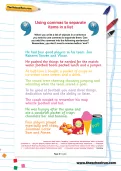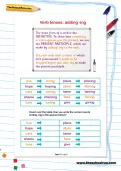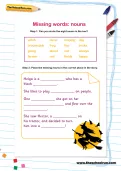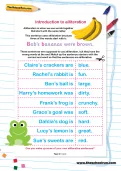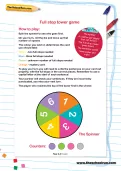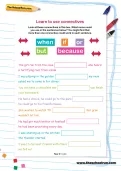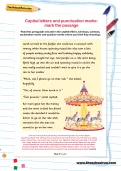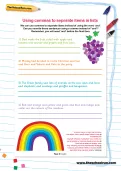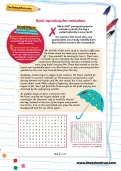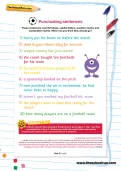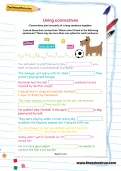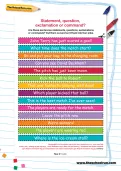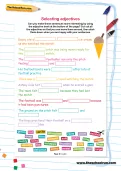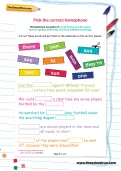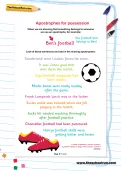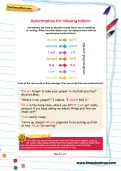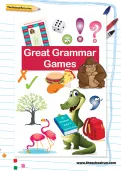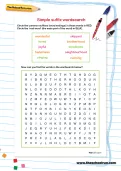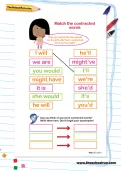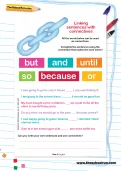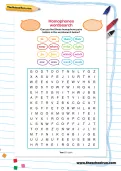Alliteration is when we use words together that start with the same letter. These sentences are supposed to use alliteration, but they have the wrong words at the end! Match up the sentence starters with the
correct end word so that the sentences are alliterative.
or
Register to add to your saved resources
Already a subscriber? to view this content.
Climb the full stop tower by correctly placing the full stop in sentences.
or
Register to add to your saved resources
Already a subscriber? to view this content.
Look at these connectives in this box. Which ones could you use in the sentences below? You might find that more than one connective could work in each sentence.
or
Register to add to your saved resources
Already a subscriber? to view this content.
A Year 2 printable worksheet created by a primary school teacher to help your child with capital letters and punctuation marks.
Read this paragraph and add in the capital letters, full stops, commas, exclamation marks and question marks where you think they should go
or
Register to add to your saved resources
Already a subscriber? to view this content.
We can use commas to separate items instead of using the word ‘and’. Can you rewrite these sentences using a comma instead of ‘and’? Remember, you will need ‘and’ before the final item.
or
Register to add to your saved resources
Ten words in this short story use apostrophes incorrectly. Identify them then find the words in the wordsearch.
or
Register to add to your saved resources
Already a subscriber? to view this content.
These sentences need full stops, capital letters, question marks and exclamation marks. Where do you think they should go?
or
Register to add to your saved resources
Already a subscriber? to view this content.
Connectives join two parts of a long sentence together. Look at these five connectives. Which ones fit best in the following sentences?
or
Register to add to your saved resources
Already a subscriber? to view this content.
When you write a list of objects in a sentence you need to use commas to separate them. Can you add the commas into these sentences? Remember, you don’t need a comma before ‘and’!
or
Register to add to your saved resources
Are these sentences statements, questions, exclamations or commands? Cut them out and sort them into four piles
or
Register to add to your saved resources
Already a subscriber? to view this content.
Can you make these sentences more interesting by using the adjective bank at the bottom of the page? Cut out all the adjectives so that you can move them around, then stick them down when you are happy with your sentences.
or
Register to add to your saved resources
Homophones are pairs of words that sound the same, but are spelled differently and have different meanings. Cut out these words and put them in the sentences in the correct places.
or
Register to add to your saved resources
Already a subscriber? to view this content.
When we are showing that something belongs to someone we use an apostrophe. Look at these sentences about football and add in the missing apostrophes.
or
Register to add to your saved resources
Already a subscriber? to view this content.
Sometimes we want to shorten words when we’re speaking or writing. When we miss letters out, we replace them with an apostrophe (contractions). Look at the red words in this passage. Can you write them as contractions?
or
Register to add to your saved resources
Already a subscriber? to view this content.
Spot the nouns then place the missing nouns in the correct place in the story.
or
Register to add to your saved resources
From proper nouns to pronouns, statements to subordinate clauses and articles to adverbs, help your child revise grammar the fun way with our Great Grammar Games learning pack. A friendly, grammar- and flamingo-obsessed Grammar Gator offers tips, tricks, exercises and activities to help your child practise all aspects of basic English grammar in play-packed sessions.
or
Register to add to your saved resources
Already a subscriber? to view this content.
Circle the common suffixes (word endings) in these words in RED. Circle the ‘root word’ (the main part of the word) in BLUE. Now can you find the words in the wordsearch?
or
Register to add to your saved resources
Already a subscriber? to view this content.
Can you match the two words on the left with their contracted form on the right? Then, think of some more contracted words and write them down. Don’t forget your apostrophe!
or
Register to add to your saved resources
Already a subscriber? to view this content.
All these words can be used as connectives. Complete the sentences using the connective that makes the most sense!
or
Register to add to your saved resources
Already a subscriber? to view this content.
Can you find these homophone pairs hidden in the wordsearch below?
or
Register to add to your saved resources
